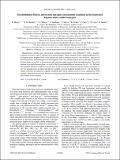Dzyaloshinskii-Moriya interaction and spin reorientation transition in the frustrated kagome lattice antiferromagnet
Author(s)
Matan, Kittiwit; Bartlett, Bart M.; Helton, Joel S.; Sikolenko, V.; Mat'as, S.; Prokes, K.; Chen, Y.; Lynn, J. W.; Grohol, D.; Sato, T. J.; Tokunaga, M.; Nocera, Daniel G.; Lee, Young S.; ... Show more Show less
DownloadMatan-2011-Dzyaloshinskii-Moriy.pdf (1.469Mb)
PUBLISHER_POLICY
Publisher Policy
Article is made available in accordance with the publisher's policy and may be subject to US copyright law. Please refer to the publisher's site for terms of use.
Terms of use
Metadata
Show full item recordAbstract
Magnetization, specific heat, and neutron scattering measurements were performed to study a magnetic transition in jarosite, a spin-5/2 kagome lattice antiferromagnet. When a magnetic field is applied perpendicular to the kagome plane, magnetizations in the ordered state show a sudden increase at a critical field Hc {H subscript c], indicative of the transition from antiferromagnetic to ferromagnetic states. This sudden increase arises as the spins on alternate kagome planes rotate 180° to ferromagnetically align the canted moments along the field direction. The canted moment on a single kagome plane is a result of the Dzyaloshinskii-Moriya interaction. For H<Hc, the weak ferromagnetic interlayer coupling forces the spins to align in such an arrangement that the canted components on any two adjacent layers are equal and opposite, yielding a zero net magnetic moment. For H>Hc [H greater than H subscript c], the Zeeman energy overcomes the interlayer coupling causing the spins on the alternate layers to rotate, aligning the canted moments along the field direction. Neutron scattering measurements provide the first direct evidence of this 180° spin rotation at the transition.
Date issued
2011-06Department
Massachusetts Institute of Technology. Department of Chemistry; Massachusetts Institute of Technology. Department of PhysicsJournal
Physical review B
Publisher
American Physical Society
Citation
Matan, K. et al. “Dzyaloshinskii-Moriya Interaction and Spin Reorientation Transition in the Frustrated Kagome Lattice Antiferromagnet.” Physical Review B 83.21 (2011) : n. pag. ©2011 American Physical Society
Version: Final published version
ISSN
1098-0121
1550-235X